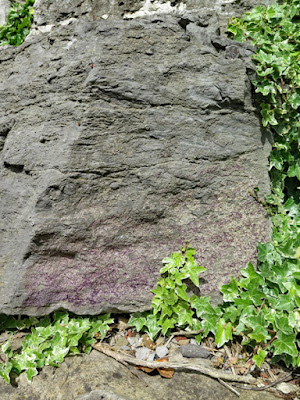In the 9th week of the COVID-19 Pandemic in 2020, there was no change in the various restrictions that had been imposed in the UK but, having discovered that I was usually the only person on the bus to the nearest supermarket at Catcliffe, I decided to travel a little bit further on the No.73 bus towards Sheffield.
Although passing through an urban area, the scarp and vale topography formed by the underlying Pennine Middle Coal Measures Formation strata along this route is very noticeable. Furthermore, the broad anticlinal structure of the Pennines, which is emphasised to the south-east of Sheffield by the Derbyshire Dome, results in a rise in elevation from 50 metres at Treeton to 150 metres at the top of Normanton Hill, where I alighted from the bus.
The car showroom at the junction of Richmond Road and Normanton Hill probably wouldn’t attract the attention of the vast majority of passers-by; however, I had always been curious about the retaining wall on its south side, comprised of roughly laid large blocks of stone, and I went to have a much closer look.
I had always assumed that these were blocks of local Carboniferous sandstone, but they are actually blocks of Carboniferous limestone, whose nearest source is more than 20 km away in the White Peak of Derbyshire.
 |
| Carboniferous limestone with lenses of chert |
When living in Bakewell many years ago, when contracted to survey a wide variety of Regionally Important Geological Sites (RIGS) in the Peak District National Park, to establish their suitability for geotourism at all levels, I encountered very many spectacular landforms and a wide variety of fossils and minerals.
Spending less than 10 minutes at Normanton Hill, without having to clamber up a rock face as I had done during a Sheffield U3A Geology Group trip to Eyam, I discovered crinoids, brachiopods, clear and purple varieties of the mineral fluorite and chert.
The study of the science of geology has long since been demoted in very many schools, universities and museums, but I think that this site provides a good example of urban geology for educational purposes and I could easily start a field trip here.
 |
| Brachiopods and chert |






I loved reading about this on your blog. I live in Huntsville, Alabama, USA and we also have carboniferous-period limestone. I crawl all over this stuff in total amazement...wondering, thinking about what the Earth was like back in that day. We also have crinoids and brachiopods...so freaking cool! Thanks for posting!
ReplyDeleteMy pleasure!
ReplyDelete